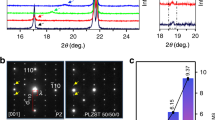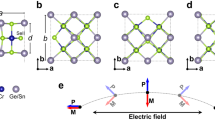Abstract
The discoveries of gigantic ferroelectric polarization in BiFeO3 (ref. 1) and ferroelectricity accompanied by a magnetic order in TbMnO3 (ref. 2) have renewed interest in research on magnetoelectric multiferroics3,4, materials in which magnetic and ferroelectric orders coexist, from both fundamental and technological points of view5,6,7. Among several different types of magnetoelectric multiferroic8,9, magnetically induced ferroelectrics in which ferroelectricity is induced by complex magnetic orders, such as spiral orders, exhibit giant magnetoelectric effects, remarkable changes in electric polarization in response to a magnetic field. Many magnetically induced ferroelectrics showing the magnetoelectric effects have been found in the past several years10. From a practical point of view, however, their magnetoelectric effects are useless because they operate only far below room temperature (for example, 28 K in TbMnO3 (ref. 2) and 230 K in CuO (ref. 11)). Furthermore, in most of them, the operating magnetic field is an order of tesla that is too high for practical applications. Here we report materials, Z-type hexaferrites, overcoming these problems on magnetically induced ferroelectrics. The best magnetoelectric properties were obtained for Sr3Co2Fe24O41 ceramics sintered in oxygen, which exhibit a low-field magnetoelectric effect at room temperature. Our result represents an important step towards practical device applications using the magnetoelectric effects.
This is a preview of subscription content, access via your institution
Access options
Subscribe to this journal
Receive 12 print issues and online access
$259.00 per year
only $21.58 per issue
Buy this article
- Purchase on Springer Link
- Instant access to full article PDF
Prices may be subject to local taxes which are calculated during checkout




Similar content being viewed by others
References
Wang, J. et al. Epitaxial BiFeO3 multiferroic thin film heterostructures. Science 299, 1719–1722 (2003).
Kimura, T. et al. Magnetic control of ferroelectric polarization. Nature 426, 55–58 (2003).
Schmid, H. Multi-ferroic magnetoelectrics. Ferroelectrics 162, 317–338 (1994).
Schmid, H. in Introduction to Complex Mediums for Optics and Electromagnetics (eds Weiglhoger, W. S. & Lakhtakia, A.) 167–195 (SPIE Press, 2003).
Hill, N. A. Why are there so few magnetic ferroelectrics? J. Phys. Chem. B 104, 6694–6709 (2000).
Fiebig, M. Revival of the magnetoelectric effect. J. Phys. D 38, R123–R152 (2005).
Eerenstein, W., Murther, N. D. & Scott, J. F. Multiferroic and magnetoelectric materials. Nature 442, 759–765 (2006).
Cheong, S-W. & Mostovoy, M. V. Multiferroics: A magnetic twist for ferroelectricity. Nature Mater. 6, 13–20 (2007).
Khomskii, D. I. Classifying multiferroics: Mechanisms and effects. Physics 2, 20 (2009).
Kimura, T. Spiral magnets as magnetoelectrics. Annu. Rev. Mater. Res. 37, 387–413 (2007).
Kimura, T., Sekio, Y., Nakamura, H., Siegrist, T. & Ramirez, A. P. Cupric oxide as an induced-multiferroic with high-TC . Nature Mater. 7, 291–294 (2008).
Smit, J. & Wijn, H. P. J. Ferrites (Phillips Technical Library, 1959).
Braun, P. B. The crystal structures of a new group of ferromagnetic compounds. Phillips Res. Rep. 12, 491–548 (1957).
Kohn, J. A., Eckart, D. W. & Cook, C. F. Jr Crystallography of the hexagonal ferrites. Science 172, 519–525 (1971).
Kimura, T., Lawes, G. & Ramirez, A. P. Electric polarization rotation in a hexaferrite with long-wavelength magnetic structures. Phys. Rev. Lett. 94, 137201 (2005).
Ishiwata, S., Taguchi, Y., Murakawa, H., Onose, Y. & Tokura, Y. Low-magnetic-field control of electric polarization vector in a helimagnet. Science 319, 1643–1646 (2008).
Taniguchi, K., Abe, N., Ohtani, S., Umetsu, H. & Arima, T. Ferroelectric polarization reversal by a magnetic field in multiferroic Y-type hexaferrite Ba2Mg2Fe12O22 . Appl. Phys. Express 1, 031301 (2008).
Chun, S. H. et al. Realization of giant magnetoelectricity in helimagnets. Phys. Rev. Lett. 104, 037204 (2010).
Albanese, G., Deriu, A. & Rinaldi, S. Sublattice magnetization and anisotropy properties of Ba3Co2Fe24O41 hexagonal ferrite. J. Phys. C 9, 1313–1323 (1976).
Pullar, R. C. & Bhattacharya, A. K. The synthesis and characterization of the hexagonal Z ferrite, Sr3Co2Fe24O41, from a sol–gel precursor. Mater. Res. Bull. 36, 1531–1538 (2001).
Takada, Y. et al. Estimation of magnetic structures of Z-type ferrites: (Ba,Sr)3Co2Fe24O41 by neutron diffraction. J. Japan Soc. Powder Powder Metall. 50, 618–625 (2003).
Takada, Y. et al. Crystal and magnetic structures and their temperature dependence of Co2 Z-type hexaferrite (Ba,Sr)3Co2Fe24O41 by high-temperature neutron diffraction. J. Appl. Phys. 100, 043904 (2006).
Utsumi, S., Yoshiba, D. & Momozawa, N. Superexchange interactions of (Ba1−xSrx)2Zn2Fe12O22 system studied by neutron diffraction. J. Phys. Soc. Jpn 76, 034704 (2007).
Tachibana, T. et al. X-ray and neutron diffraction studies on iron-substituted Z-type hexagonal barium ferrite: (Ba,Sr)3Co2−xFe24+xO41 (x=0–0.6). J. Magn. Magn. Mater. 262, 248–257 (2003).
Kimura, O., Matsumoto, M. & Sakakura, M. Enhanced dispersion frequency of hot-pressed Z-type magnetoplumbite ferrite with the composition 2CoO·3Ba0.5Sr0.5O·10.8Fe2O3 . J. Am. Ceram. Soc. 78, 2857–2860 (1995).
Katsura, H., Nagaosa, N. & Balatsky, A. V. Spin current and magnetoelectric effect in noncollinear magnets. Phys. Rev. Lett. 95, 057205 (2005).
Kenzelmann, M. et al. Magnetic inversion symmetry breaking and ferroelectricity in TbMnO3 . Phys. Rev. Lett. 95, 087206 (2005).
Mostovoy, M. Ferroelectricity in spiral magnets. Phys. Rev. Lett. 96, 067601 (2006).
Sergienko, I. A. & Dagotto, E. Role of the Dzyaloshinskii–Moriya interaction in multiferroic perovskites. Phys. Rev. B 73, 094434 (2006).
Acknowledgements
We thank T. Takeuchi for his help in magnetization measurements, and T. Asaka and Y. Wakabayashi for fruitful discussions. This work was supported by KAKENHI (Grant Nos 20674005, 20001004 and 19052001) and Global COE Program (Program No. G10), MEXT, Japan.
Author information
Authors and Affiliations
Contributions
Y.K., Y.H. and T.K. initiated this work. Y.K. carried out sample preparation and characterization as well as magnetic, electric and magnetoelectric measurements, with assistance from Y.H. and H.N.; T.I. and H.N. also carried out all of the above experiments to confirm the reproducibility of the results. T.H. analysed the X-ray diffraction data and clarified the impurity phases. T.K. designed and directed the research, and wrote the paper.
Corresponding author
Ethics declarations
Competing interests
The authors declare no competing financial interests.
Rights and permissions
About this article
Cite this article
Kitagawa, Y., Hiraoka, Y., Honda, T. et al. Low-field magnetoelectric effect at room temperature. Nature Mater 9, 797–802 (2010). https://doi.org/10.1038/nmat2826
Received:
Accepted:
Published:
Issue Date:
DOI: https://doi.org/10.1038/nmat2826
This article is cited by
-
Structural and magnetic properties of Ni-substituted Y-type Ba0.5Sr1.5Zn2−xNixFe12O22 (x = 0, 0.5, 1.0, and 1.5) hexaferrite
Journal of Materials Science: Materials in Electronics (2023)
-
Effect of La substitution on the structural and chemical properties of Barium hexaferrite via Mossbauer spectroscopy
Hyperfine Interactions (2023)
-
γ-BaFe2O4: a fresh playground for room temperature multiferroicity
Nature Communications (2022)
-
The study of CoFe2O4/Ba0.85Ca0.15Zr0.1Ti0.9O3-laminated composite ceramic on dielectric, relaxation, ferroelectric, and magnetoelectric coupling properties
Journal of Materials Science: Materials in Electronics (2022)
-
Investigation on the structural, magnetic, and dielectric properties of Ni2+–Zr4+ co-doped Y-type hexaferrite Ba2Ni2Fe12O22
Journal of Materials Science: Materials in Electronics (2022)



